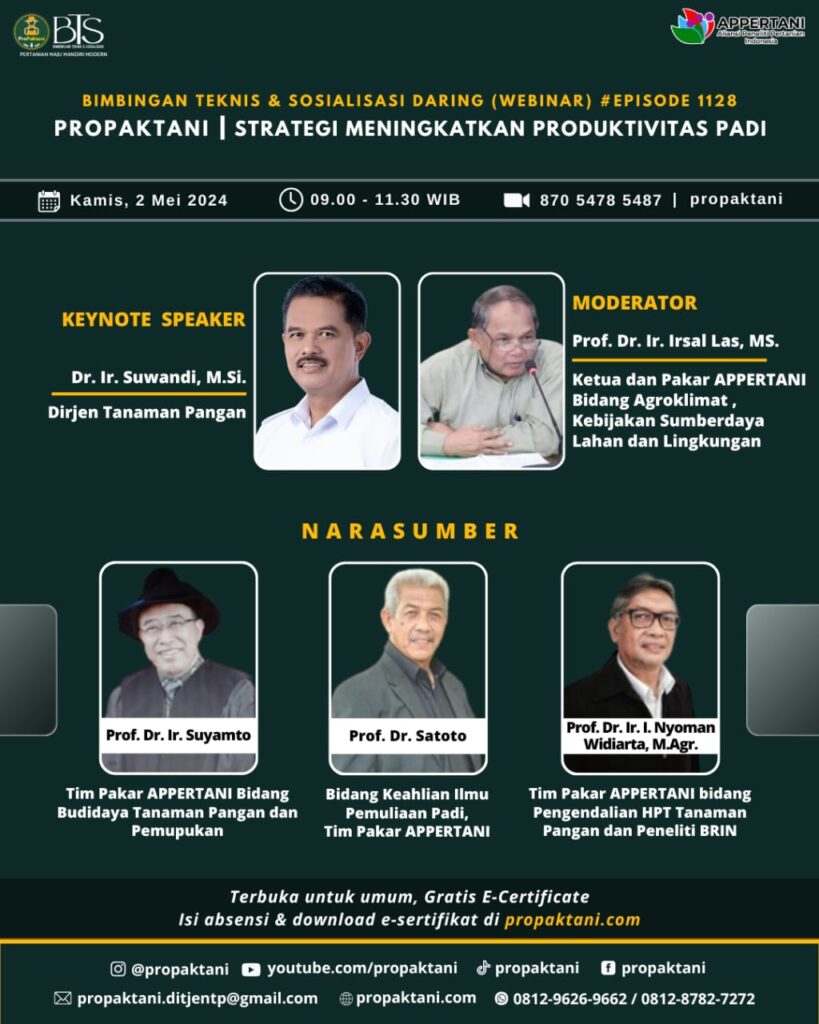Online Socialization and Technical Guidance (WEBINAR) #EPISODE 1128 PROPAKTANI

Strategies to Increase Rice Productivity
Dr. Suwandi, Director General of Food Crops in his keynote speech outlined the steps being taken to increase rice production through extensification and intensification. Extensification is carried out by expanding the planting area and increasing the planting index. Intensification is carried out by increasing the yield potential of new high-yielding varieties of rice and improving crop cultivation management. Propaktani episode 1128 organized by APPERTANI discusses the Strategy to Increase Rice Productivity as the main factor in increasing production. The moderator of this webinar episode was Prof. Dr. Ir. Irsal Las, MS, Chairman and APPERTANI expert team in the field of Agroclimatic, Land Resources Policy and the Environment.

Prof. Dr. Ir. Suyamto, MS., APPERTANI Expert Team in the Field of Expertise in Food Crop Cultivation and Fertilization delivered the topic: “Strategy for Preparation and Application of Rice Farming Technology Packages in Various Agroecology”. Rice farming can be done on irrigated rice fields (full, semi-technical), rainfed rice fields, dry lands, and swamplands, each of which has potential and problems that greatly determine the technology package or technological component intervention integrated in a particular package. Currently, there are superior technology packages for rice crops for irrigated, rain-fed, swampy and dry land accompanied by the key to successful application of technology. Increasing the understanding and application of farmer technology is a very important aspect to strive for because there is still a gap in the application of technology between the advanced technology available and the technology applied by farmers. Need monitoring in the field and evaluation of the results of the application of technology packages. The role of extension workers, heads of farmer groups, field officers, researchers, agencies, and other related parties is very important to find and continuously update technology components that are proven superior and adaptive from various sources, and coordinate and facilitate the formulation of technology packages and their application in the field.

Prof. Dr. Satoto, The APPERTANI Food Crop Improvement Expert Team delivered material on the topic: “Strategy for Increasing Rice Plant Productivity in terms of Genetic Approach”. The focus of rice breeding is to increase productivity through improving yield potential and adaptability to negative biotic and abiotic impacts of climate change. The direction of the approach is carried out by increasing yield potential and minimizing yield loss due to biotic and / abiotic stress. Concrete steps are recommended to be taken through 1) conventional crossing and selection; 2) breeding of the ideal type (ideotype approach); 3) hybrid rice breeding (heterosis approach); 4) wide hybridization, and 5) genetic engineering through the introduction of genes from other species. Adaptation strategies to climate change through the assembly of high-yielding varieties with improved traits: 1) improved resistance to pests; 2) early or very early maturing rice; 3) drought tolerant; 4) standing flood tolerance; 5) salinity tolerance; 6) efficient input, and 7) low methane gas emission.
Prof. Dr. I Nyoman Widiarta, The APPERTANI Food Crop Pest and Disease Control Expert Team and BRIN Researchers delivered material with the topic: “Suppression of Rice Yield Loss with Integrated Pest Management supported by the Provision of In-situ Seeds of Site-Specific Resistant Varieties”. Increasing rice productivity is one of the main production factors to increase rice production, to achieve Sustainable Rice Self-Sufficiency and World Food Granary 2045. The productivity or yield of rice varieties per unit area is determined by yield potential, environmental conditions and management of cultivation, harvest, and post-harvest. The extent of pest attacks and major rice diseases is one of the biotic environmental conditions that can cause yield losses that hinder the increase in rice productivity. The La-Nina climate anomaly, which is characterized by wet dry season conditions, causes an increase in rice pests and diseases invested area, especially brown planthoppers accompanied by rice dwarf disease caused by the virus it transmits and tungro disease. Adaptation strategies for the negative impact of La-Nina on rice yield loss can be pursued by implementing integrated pest management that integrates pest and/disease resistant varieties with other compatible control technology components. Increased adoption of site-specific adaptive resistant varieties is pursued by breeding reorientation by meeting supply with demand and supported by in-situ seed provision.

